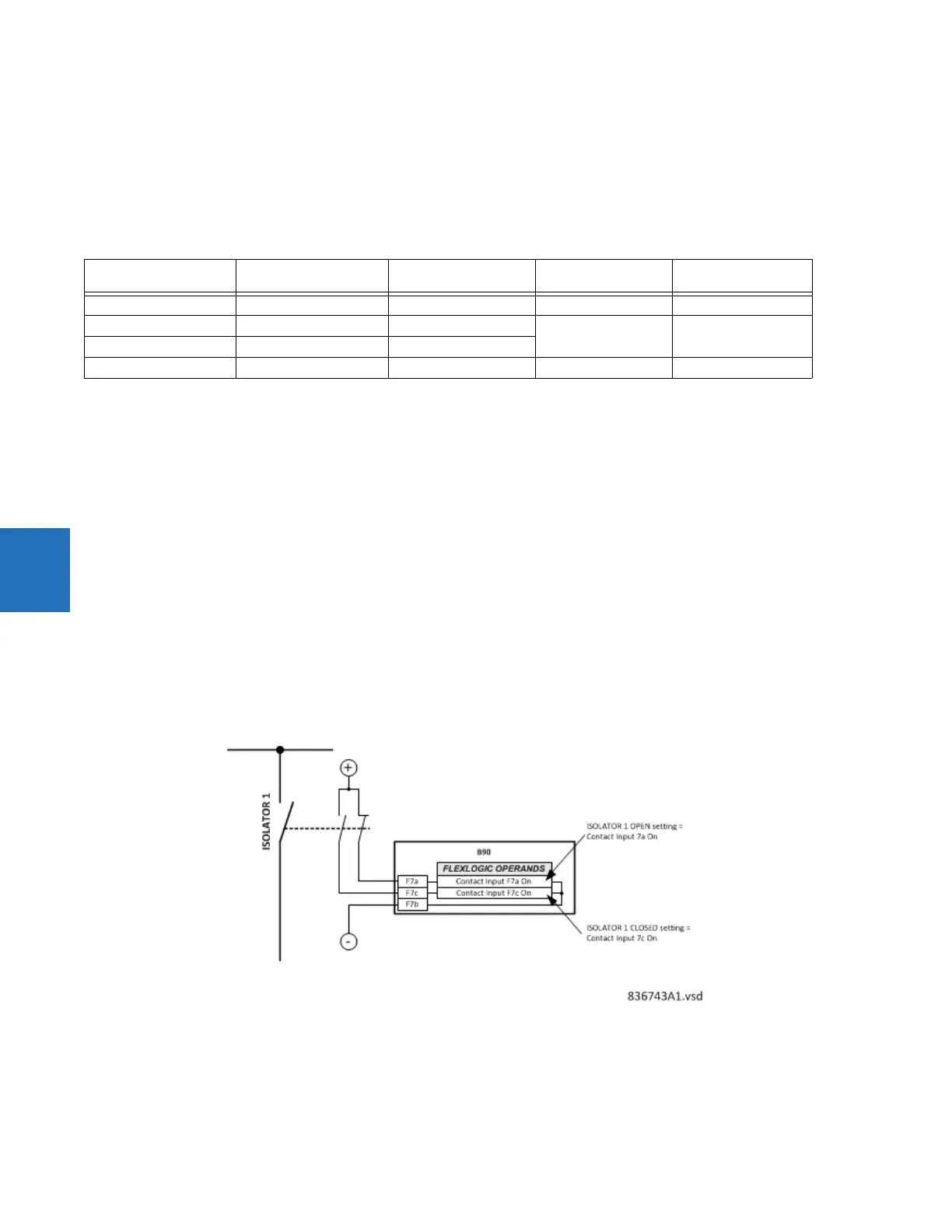5-188 B90 LOW IMPEDANCE BUS DIFFERENTIAL SYSTEM – INSTRUCTION MANUAL
CONTROL ELEMENTS CHAPTER 5: SETTINGS
5
Bus protection zone discrimination depends heavily on reliable isolator position feedback. Therefore, two isolator auxiliary
contacts – normally open and normally closed – must confirm the status of the isolator via the B90 contact inputs.
This element responds to both normally open and normally closed auxiliary contacts of an isolator or a tie-breaker in order
to assert the actual position of the isolator for the dynamic bus image. The element asserts two extra output operands
indicating "isolator alarm" (auxiliary contact discrepancy), and "block switching operations in the substation." The
operation of the element is summarized in the following table.
Table 5-30: Isolator monitoring logic
The position of an isolator is indicated by the ISOLATOR N POSITION FlexLogic operand (On = Closed, Off = Open). This operand
is used as a circuit connection status for the bus configuration. When "On", the related current is associated with a given
differential zone; when "Off", the current is excluded from differential calculations.
An isolator alarm FlexLogic operand, ISOLATOR 1 ALARM, is asserted after a settable time delay if the auxiliary contacts of the
isolator do not match (open-open, closed-closed instead of open-closed or closed-open), yielding an undefined isolator
position. The operand may be used to block user-selected protection functions and may be reset manually or remotely via
the resetting input operand.
The ISOLATOR 1 BLOCK operand is asserted as long as the isolator position is invalid. This operand may be used to block
switching operations in the substation. Typically, breakers and isolators that control currents flowing through a given
isolator shall be blocked from operation as long as isolator position is not resolved.
The element is effectively enabled only when
PRODUCT SETUP B90 FUNCTION B90 FUNCTION is set to “Logic.” See the
Application of Settings chapter for details on the usage of the Bus Replica element.
ISOLATOR 1 OPEN — This setting specifies a FlexLogic operand that represents an auxiliary contact of the monitored isolator.
Typically this setting is a status of an appropriately wired input contact (“On” = isolator open).
ISOLATOR 1 CLOSED — This setting indicates a FlexLogic operand that represents an auxiliary contact of the monitored
isolator. Typically this setting is a status of an appropriately wired input contact (“On” = isolator closed).
Figure 5-102: Typical isolator open/closed settings
ISOLATOR 1 ALARM DELAY — This setting specifies a time delay after which an isolator alarm is issued by asserting the
operand assigned to ISOLATOR 1 ALARM. Set the delay longer than the slowest operation (transition) time of the isolator.
ISOLATOR 1 RESET — This setting indicates a FlexLogic operand that acknowledges the isolator alarm. Once the alarm is
acknowledged, the ISOLATOR 1 ALARM is reset. If the latter operand was configured to block protection, the blocking is
removed once the alarm is acknowledged. The acknowledge pulse must last at least 50 ms to take effect.
Isolator open
auxiliary contact
Isolator closed
auxiliary contact
Isolator position Alarm Block switching
Off On CLOSED No No
Off Off LAST VALID After time delay
until acknowledged
Until Isolator
Position is valid
On On CLOSED
On Off OPEN No No

